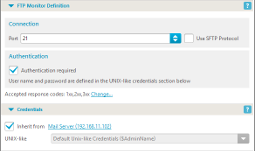FTP Monitor is a simple type of IPHost Monitor. FTP, or File Transfer Protocol, is a well-known and widely used protocol for transmitting data (files). Although FTP itslef is insecure, there are many related and/or derived protocols providing enough security level. Monitoring FTP servers is required to ensure data flow is not interrupted (since FTP servers are often used for backup purposes).
Monitoring FTP manually is an easy task, via ftp or general telnet client. As with many other types of monitoring, using automated monitoring means would reduce time required to test the service for availability. Testing FTP connection, in fact, checks not only the general availability if the server, but credentials validity as well. The lack of thorough testing may result in unexpected FTP service downtime (if possible trouble indicators were not paid attention to). IPHost Network Monitor provides a simple solution for this.
IPHost FTP Monitor is a simple type of monitor. After specifying host name and port number (in case default port isn’t used), you can also provide user name and password to check authentication; there’s also a checkbox allowing to use SFTP secure version of the protocol. Accepted response codes (comma separated) can be used, if a particular response code from the server is considered good. Note that SFTP doesn’t provide response code in general; it returns code 530 to indicate authentication failure (add this to accepted response codes list if necessary).
FTP Monitor is a simple tool, its role is to verify connectivity and credentials validity. It can be successfully used, for example, as one of indicators of a Web site health; of a backup service and so on. Thus, any user can utilize this monitor to verify their Web site is capable of accepting data to upload. System administrators can verify backup service state in this way.
As with any application protocol, it is advised to combine FTP Monitor with lighter monitors such as PING or TCP. Also, common use case would be using FTP monitor in conjunction with HTTP, MySQL, Web Transaction and other types of monitors used by a given host (i.e., a Web server). If credentials are supplied, FTP Monitor will also verify the authentication works as expected and/or credentials haven’t changed.
Description of other features:
| Monitoring Features | Here you can find the list of monitor types supported in IPHost Network Monitor and brief description of their parameters. |
| Application Templates | Here you can find the list of application templates supported in IPHost Network Monitor and their short description. |
| Network Discovery | Helps you to create a basis of your monitoring configuration and automates the task of detection network hosts and network services. |
| Alerting Features | Here you can find the list of alert types (ways of reaction to the problems happened during monitoring) available in IPHost Network Monitor, and their brief description. |
| Reporting Features | Here you can find the list of report types available in IPHost Network Monitor with brief descriptions. |
| IPHost Network Monitor interfaces and structure |
Here you can find an overview of IPHost Network Monitor components, Windows and web interfaces. |



Comments are closed.